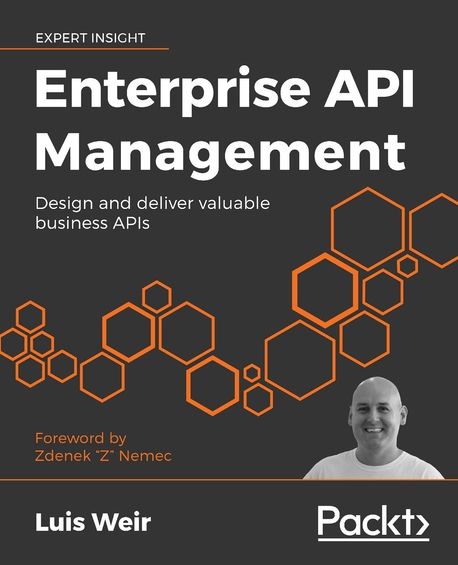Enterprise API Management
2019년 07월 23일 출간
- eBook 상품 정보
- 파일 정보 PDF (14.36MB)
- ISBN 9781787285613
- 지원기기 교보eBook App, PC e서재, 리더기, 웹뷰어
-
교보eBook App
듣기(TTS) 가능
TTS 란?텍스트를 음성으로 읽어주는 기술입니다.
- 전자책의 편집 상태에 따라 본문의 흐름과 다르게 텍스트를 읽을 수 있습니다.
- 이미지 형태로 제작된 전자책 (예 : ZIP 파일)은 TTS 기능을 지원하지 않습니다.
PDF 필기가능 (Android, iOS)

쿠폰적용가 21,600원
10% 할인 | 5%P 적립이 상품은 배송되지 않는 디지털 상품이며,
교보eBook앱이나 웹뷰어에서 바로 이용가능합니다.
카드&결제 혜택
- 5만원 이상 구매 시 추가 2,000P
- 3만원 이상 구매 시, 등급별 2~4% 추가 최대 416P
- 리뷰 작성 시, e교환권 추가 최대 200원
작품소개
이 상품이 속한 분야
APIs are the cornerstone of modern, agile enterprise systems. They enable access to enterprise services from a wide variety of devices, act as a platform for innovation, and open completely new revenue streams.
Enterprise API Management shows how to define the right architecture, implement the right patterns, and define the right organization model for business-driven APIs.
Drawing on his experience of developing API and microservice strategies for some of the world's largest companies, Luis Weir explains how APIs deliver value across an enterprise. The book explores the architectural decisions, implementation patterns, and management practices for successful enterprise APIs, as well as providing clear, actionable advice on choosing and executing the right API strategy in your enterprise.
With a relentless focus on creating business value, Luis Weir reveals an effective method for planning, building, and running business products and services with APIs.
▶What You Will Learn
- Create API strategies to deliver business value
- Monetize APIs, promoting them through public marketplaces and directories
- Develop API-led architectures, applying best practice architecture patterns
- Choose between REST, GraphQL, and gRPC-style API architectures
- Manage APIs and microservices through the complete life cycle
- Deploy APIs and business products, as well as Target Operating Models
- Lead product-based organizations to embrace DevOps and focus on delivering business capabilities
▶Key Features
- Comprehensive, end-to-end guide to business-driven enterprise APIs
- Distills years of experience with API and microservice strategies
- Provides detailed guidance on implementing API-led architectures in any business
▶Who This Book Is For
Architects, developers, and technology executives who want to deliver successful API strategies that bring business value.
1 The Business Value of APIs
2 The Evolution of API Platforms
3 Business-Led API Strategy
4 API-Led Architectures
5 API-Led Architecture Patterns
6 Modern API Architectural Styles
7 API Life Cycle
8 API Products' Target Operating Model
▶What this book covers
- Chapter 1, The Business Value of APIs ? this chapter gives context to the rest of the book by elaborating on what APIs mean to a business and why they should be embraced. It also talks about business drivers for APIs and how to determine their value based on an API value chain.
- Chapter 2, The Evolution of API Platforms ? this chapter takes a step back to look in detail at how technologies and platforms have evolved from traditional middleware and enterprise service bus-centric SOA architectures to fully federated, multi-cloud, and microservices-based architectures that enable APIs to exist and be managed wherever information resides.
- Chapter 3, Business-Led API Strategy ? the main focus of this chapter is to deliver a comprehensive approach to defining API strategies that have clear, concise, and businesscentric goals and objectives.
- Chapter 4, API-Led Architectures ? this chapter walks through a reference architecture and all of the capabilities required to implement modern APIs and fully decouple (micro)services. The chapter is a great reference for what modern stacks should look like.
- Chapter 5, API-Led Architecture Patterns ? this chapter extends Chapter 4 by walking through how the different capabilities described in the reference architecture can be combined in order to deliver sound solutions to common problems.
- Chapter 6, Modern API Architectural Styles ? this chapter gives a detailed overview of the trendiest API architectural styles (at the time this book was written). The chapter is a great source of inspiration for anyone looking for a point of view on different API styles and their pros and cons.
- Chapter 7, API Life Cycle ? this chapter walks through the full API life cycle and also related ones, such as the service and API consumer life cycles. The chapter is a great reference for those wishing to implement end-to-end API processes and tools from scratch or anyone looking for inspiration on how to enhance existing ones.
- Chapter 8, API Products' Target Operating Model ? as the name suggests, the chapter walks through what it really means to treat APIs as products and the implications this has for organizations. From core concepts to different operating models with their pros and cons, this chapter elaborates on a topic that is rarely discussed in the world of APIs.
▶ Preface
Application Programming Interfaces (APIs) can be compared to doors: their main purpose is to provide access to something. Doors come in different shapes, sizes, colors, and materials, and offer different levels of security to protect whatever is behind them.
In the case of APIs, however, that something is digital assets such as raw and cleansed data, images, videos, documents, and even functionality that performs complex calculations or data processing based on inputs.
The same is also true with APIs. API management is a discipline that has evolved to deliver the processes and tools required to discover, design, implement, use, or operate enterprisegrade APIs. Most importantly, the discipline is responsible for managing the communities around APIs. Such communities may consist of developers building and/or using APIs in their apps, but there are also communities of business and IT executives looking to speed up innovation at a lower cost.
We can conclude that API management's true objective is to deliver value. This could be valuable to the business in the form of reducing development effort by using existing APIs (internally developed ones or external ones developed by third parties). Value could also come from monetizing APIs that offer intangible products (digital assets) that developers and/or executives alike would be willing to pay for.
Value can only be truly delivered when the full cycle of delivering something, in this case APIs, is fully understood, optimized, and overseen. The creation of an API strategy with a clear purpose and objectives is followed by the inception of an API through innovation workshops. Next is planning, design, implementation, deployment, operations, and monitoring, until the eventual retirement of the API.
API management is no longer just about implementing APIs. Thousands of public APIs (with more being added by the day) are listed in API marketplaces, such as programmableweb.com, and RapidAPI.com, each representing a digital door to an organization's digital product offerings. Thinking that all APIs need to be internally developed is a huge fallacy.
To summarize, API management must be as much about providing the means to discover and use public APIs as it is about implementing new ones. At the epicenter of any API management initiative must be the creation of value for the business but also for the users of an API.
인물정보
저자(글) Luis Weir
Luis Augusto Weir is a Director of Software Development at Oracle and a former Chief Architect at Capgemini, Oracle Ace Director and Oracle Groundbreaker Ambassador. An API management and microservices evangelist, Luis has over 17 years of experience implementing complex distributed systems around the world.Co-author of 3 other books as well as numerous articles and white papers, Luis has been a frequent speaker frequent speaker at known events such as CodeOne, Devoxx, Gartner AAD&I, Oracle OpenWorld, Java2Days and many user groups and meetups.Luis holds an MS in Corporate Networks and Systems Integration from the Universitat Politecnica de Valencia (UPV) and a BS in Electronics Engineering from the Universidad Nueva Esparta.
이 상품의 총서
Klover리뷰 (0)
- - e교환권은 적립일로부터 180일 동안 사용 가능합니다.
- - 리워드는 5,000원 이상 eBook, 오디오북, 동영상에 한해 다운로드 완료 후 리뷰 작성 시 익일 제공됩니다. (2024년 9월 30일부터 적용)
- - 리워드는 한 상품에 최초 1회만 제공됩니다.
- - sam 이용권 구매 상품 / 선물받은 eBook은 리워드 대상에서 제외됩니다.
- 도서나 타인에 대해 근거 없이 비방을 하거나 타인의 명예를 훼손할 수 있는 리뷰
- 도서와 무관한 내용의 리뷰
- 인신공격이나 욕설, 비속어, 혐오 발언이 개재된 리뷰
- 의성어나 의태어 등 내용의 의미가 없는 리뷰
구매 후 리뷰 작성 시, e교환권 100원 적립
문장수집
- 구매 후 90일 이내에 문장 수집 등록 시 e교환권 100원을 적립해 드립니다.
- e교환권은 적립일로부터 180일 동안 사용 가능합니다.
- 리워드는 5,000원 이상 eBook에 한해 다운로드 완료 후 문장수집 등록 시 제공됩니다. (2024년 9월 30일부터 적용)
- 리워드는 한 상품에 최초 1회만 제공됩니다.
- sam 이용권 구매 상품 / 선물받은 eBook / 오디오북·동영상 상품/주문취소/환불 시 리워드 대상에서 제외됩니다.
구매 후 문장수집 작성 시, e교환권 100원 적립
신규가입 혜택 지급이 완료 되었습니다.
바로 사용 가능한 교보e캐시 1,000원 (유효기간 7일)
지금 바로 교보eBook의 다양한 콘텐츠를 이용해 보세요!

- 구매 후 90일 이내 작성 시, e교환권 100원 (최초1회)
- 리워드 제외 상품 : 마이 > 라이브러리 > Klover리뷰 > 리워드 안내 참고
- 콘텐츠 다운로드 또는 바로보기 완료 후 리뷰 작성 시 익일 제공
가장 와 닿는 하나의 키워드를 선택해주세요.
총 5MB 이하로 jpg,jpeg,png 파일만 업로드 가능합니다.
신고 사유를 선택해주세요.
신고 내용은 이용약관 및 정책에 의해 처리됩니다.
허위 신고일 경우, 신고자의 서비스 활동이 제한될 수
있으니 유의하시어 신중하게 신고해주세요.
이 글을 작성한 작성자의 모든 글은 블라인드 처리 됩니다.
구매 후 90일 이내 작성 시, e교환권 100원 적립
eBook 문장수집은 웹에서 직접 타이핑 가능하나, 모바일 앱에서 도서를 열람하여 문장을 드래그하시면 직접 타이핑 하실 필요 없이 보다 편하게 남길 수 있습니다.
차감하실 sam이용권을 선택하세요.
차감하실 sam이용권을 선택하세요.
선물하실 sam이용권을 선택하세요.
-
보유 권수 / 선물할 권수0권 / 1권
-
받는사람 이름받는사람 휴대전화
- 구매한 이용권의 대한 잔여권수를 선물할 수 있습니다.
- 열람권은 1인당 1권씩 선물 가능합니다.
- 선물한 열람권이 ‘미등록’ 상태일 경우에만 ‘열람권 선물내역’화면에서 선물취소 가능합니다.
- 선물한 열람권의 등록유효기간은 14일 입니다.
(상대방이 기한내에 등록하지 않을 경우 소멸됩니다.) - 무제한 이용권일 경우 열람권 선물이 불가합니다.
첫 구매 시 교보e캐시 지급해 드립니다.

- 첫 구매 후 3일 이내 다운로드 시 익일 자동 지급
- 한 ID당 최초 1회 지급 / sam 이용권 제외
- 구글바이액션을 통해 교보eBook 구매 이력이 없는 회원 대상
- 교보e캐시 1,000원 지급 (유효기간 지급일로부터 7일)




